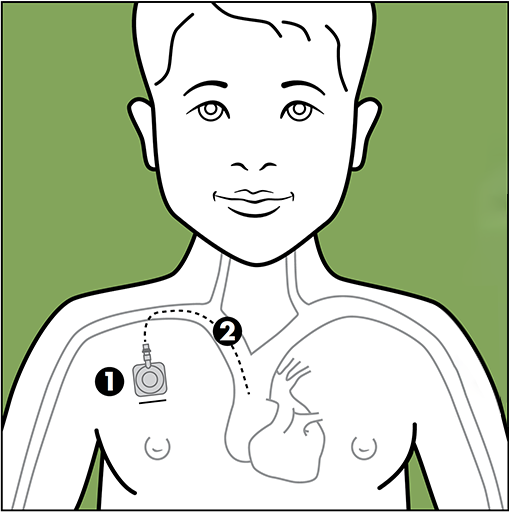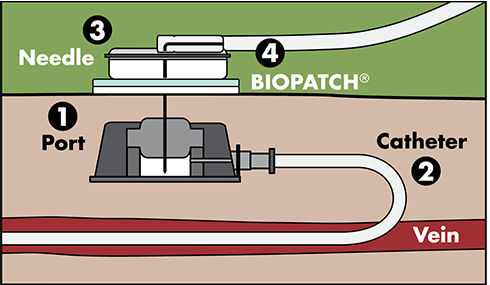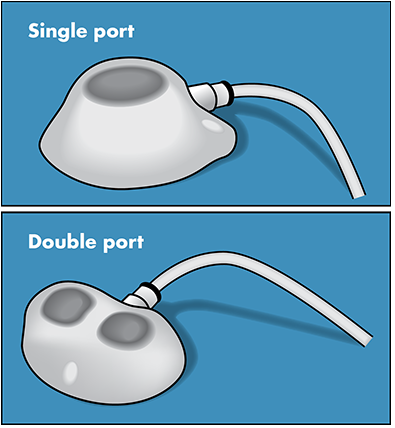An introduction to your child’s implanted central venous catheter device
Download An Introduction to Your Child’s Implanted Central Venous Catheter Device information sheet
Why does my child need an implanted catheter (Port-a-Cath®)?
- To decrease the number of times your child is poked with a needle
- To administer medications and fluids into a large vein
- To draw most blood samples
Parts of an implanted catheter (Port-a-Cath®)?
- A small device placed in surgery.
- This line is implanted entirely under the skin.
- It may be located in the chest, abdomen, or arm.
Implanted catheter (Port-a-Cath®)

- Inside the body, the implanted catheter (port) has 2 parts: (1) a small rubber dome and (2) an attached flexible tube (catheter) that goes into a large vein leading to the heart.
- The device will look and feel like a small bump under the skin.
- When treatments are given, a (3) special needle with attached tubing is inserted through the skin into the rubber dome.
- A (4) medicated disc (BIOPATCH®) is placed under the needle. A clear, plastic dressing is then placed over the needle to help keep the needle in place. The dressing and medicated disc help prevent bacteria from entering the body.

After the catheter is placed

- Your child may feel sore for a day or two and the area may be swollen.
- There will be small incisions to your child’s skin covered with small sterile
tape (Steri-strips®). - The implanted catheter will be “accessed” with a special needle. See picture above
- When in the hospital, the dressing and needle must be changed once per week.
- Bacteria and germs can enter the bloodstream through the line if the dressing and skin is not kept clean and dry.
- If dressing or BIOPATCH® gets wet or starts to peel up, please ask your provider to change it. This is a sterile procedure and should only be done by trained professionals.
- When at home, the implanted catheter needs to be accessed and flushed once a month with an anticlotting medicine called heparin. This can be done in the clinic or by the home health nurse.
-
Next time the catheter is used
- There will be a “poke” when the catheter is accessed with a special needle at the start of each treatment.
- If desired, your child can be prescribed a cream to put on 30 minutes before the needle is placed. The cream may help to decrease discomfort when needle is used to access the implanted catheter.
- Carry your “This is My Lifeline” info card with you. Show providers when necessary.
-
Advantages of an implanted central catheter
- When not accessed, the device is completely under the skin with no tubes outside of the body.
- There is less risk of infection than other central venous catheters.
- Your child can take baths when the catheter is not accessed.
- The catheter can stay in as long as your child needs treatments.
-
Signs to watch for and alert your child’s doctor
- A fever may be a sign of infection.
- Call your doctor for a temperature greater than 100.4˚ F or as instructed by your doctor.
- Do not give Tylenol® or Motrin® unless instructed to do so by your doctor.
- Chills
- Pain, redness or bruising around the implanted catheter site
- Swelling at the site especially when the catheter is being used
- Chest or neck pain, trouble breathing. THIS IS AN EMERGENCY. Lay your child on their left side and keep calm. CALL 911.
- A fever may be a sign of infection.
Important points

- Be sure your child’s teachers, school nurse, and PE teacher know about the implanted catheter.
- Children may resume most usual activities. No roughhousing or contact sports. Talk with your doctor for more specific instructions.
- Avoid any direct hits to the implanted catheter site.
It is important that any doctors or nurses taking care of your child know your child has an implanted catheter. Since the device is completely under the skin, they might not be aware of it. This is especially important if your child is being seen in the emergency department or any clinic or hospital.

